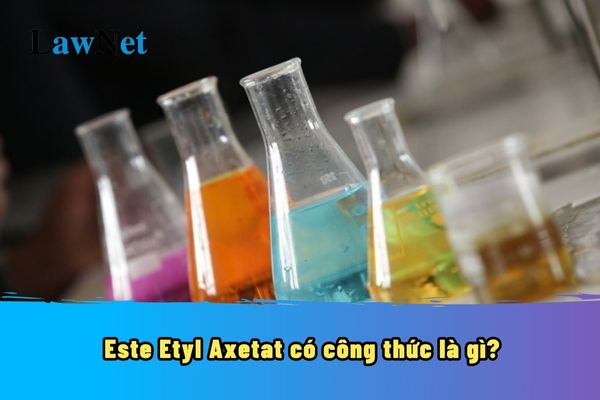What is the formula for Ethyl Acetate? According to the characteristics of the new program, which skills will students in Vietnam acquire when learning Chemistry?
What is the formula for Ethyl Acetate?
The formula CH₃COOCH₂CH₃ indicates that ethyl acetate is formed from the reaction between acetic acid (CH₃COOH) and ethyl alcohol (CH₃CH₂OH).
Formula of Ethyl Acetate Ester
Ethyl acetate is an organic ester with a fruity aroma, commonly used as a solvent in many industries.
The chemical formula of ethyl acetate is:
CH₃COOCH₂CH₃
*Molecular Structure of Ethyl Acetate
Functional group of ester: -COO- (bond between the acyl group -CO- and the alkyl group -OR)
Radical R: In this case, R is the ethyl radical (-CH₂CH₃)
Radical R': In this case, R' is the acetyl radical (-COCH₃)
How to read the formula:
CH₃: Methyl radical
COO: Ester group
CH₂CH₃: Ethyl radical
*Note: Information is for reference purposes only./.

What is the formula for Ethyl Acetate? According to the characteristics of the new program, which skills will students in Vietnam acquire when learning Chemistry? (Image from the Internet)
According to the characteristics of the new program, which skills will students in Vietnam acquire when learning Chemistry?
According to Section 1 of the Chemistry subject curriculum in general education issued together with Circular 32/2018/TT-BGDDT:
SUBJECT CHARACTERISTICS
Chemistry is a science within the field of natural sciences, studying the composition, structure, properties, and changes of elements and compounds.
Chemistry closely combines theory and experimentation, serving as a bridge to other natural sciences such as physics, biology, medicine, and geology. Advances in chemistry are associated with the development of new discoveries in biology, medicine, and physics. Chemistry plays an important role in life and production, contributing to socio-economic development. Achievements in chemistry are applied in the fields of materials, energy, medicine, biotechnology, agriculture, forestry, fisheries, and many other areas.
In the general education curriculum, Chemistry is a subject within the group of natural science subjects at the high school level, chosen by students following career orientation, interests, and capabilities. The Chemistry subject helps students acquire core knowledge of chemistry and apply this knowledge to life while maintaining relationships with other educational fields. Together with Mathematics, Physics, Biology, Information Technology, and Technology, the Chemistry subject contributes to promoting STEM education, one of the educational trends valued in many countries around the world.
The content of the Chemistry subject is designed into topics ensuring to consolidate the content systems, develop knowledge and practical skills formed from the lower level, and help students have a deeper understanding of chemistry’s foundational general knowledge, serving as a basis for studying, working, and researching.
...
Accordingly, the new program features in Chemistry help students acquire core knowledge of chemistry and apply this knowledge to life, while having connections with multiple other educational fields.
What are regulations on ensuring inheritance and development when building the Chemistry curriculum in Vietnam?
According to Section 2 of the Chemistry subject curriculum in general education issued together with Circular 32/2018/TT-BGDDT ensuring inheritance and development when building the Chemistry curriculum:
- Ensure Inheritance and Development
+ The Chemistry curriculum inherits and promotes the advantages of the current program, incorporates experiences from chemistry curriculum development in countries with advanced education systems worldwide and in the region; concurrently, it approaches the achievements of educational sciences, chemical sciences appropriate to students' cognitive levels, psychological age, considering Vietnam's economic and social conditions.
+ The Chemistry curriculum inherits and develops educational content of the Natural Science subject at the middle school level through a concentric combined linear structure aiming to expand and enhance knowledge and skills for students.
At the middle school level, through the Natural Science subject, students become familiar with basic chemical knowledge at a qualitative, intuitively descriptive level.
At the high school level, the Chemistry subject emphasizes providing students with fundamental chemistry knowledge about the structure, properties, and applications of elements and compounds so students can explain the nature of chemical processes at a necessary level.
- Ensure Practicality
The Chemistry curriculum emphasizes practicality; avoids tendencies towards calculation; focuses on equipping tool concepts and methods of using tools, particularly helping students have experimental practice skills, and the ability to apply chemistry knowledge to understand and solve, to a certain level, practical issues, meeting life's demands.
- Implement Career Orientation Requirements
The Chemistry curriculum concretizes career orientation educational goals. Based on determining the occupational fields and technological processes requiring in-depth chemistry knowledge, the program selects core educational content and study topics, helping students delve deeper into chemistry knowledge with practical applications, preparing for career orientation.
- Promote Student Activeness
The educational methods of the Chemistry subject contribute to promoting students' activeness, proactiveness, and creativity, aiming to form chemistry competencies and contribute to forming and developing essential qualities and general competencies as defined in the Overall Program.

